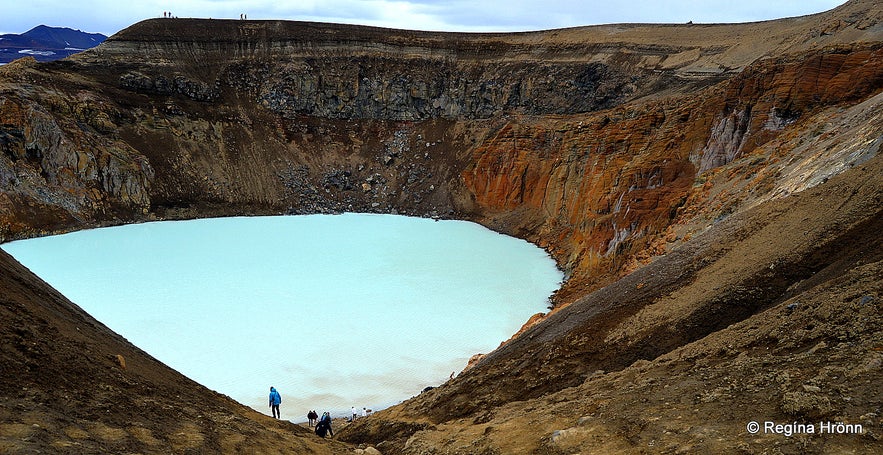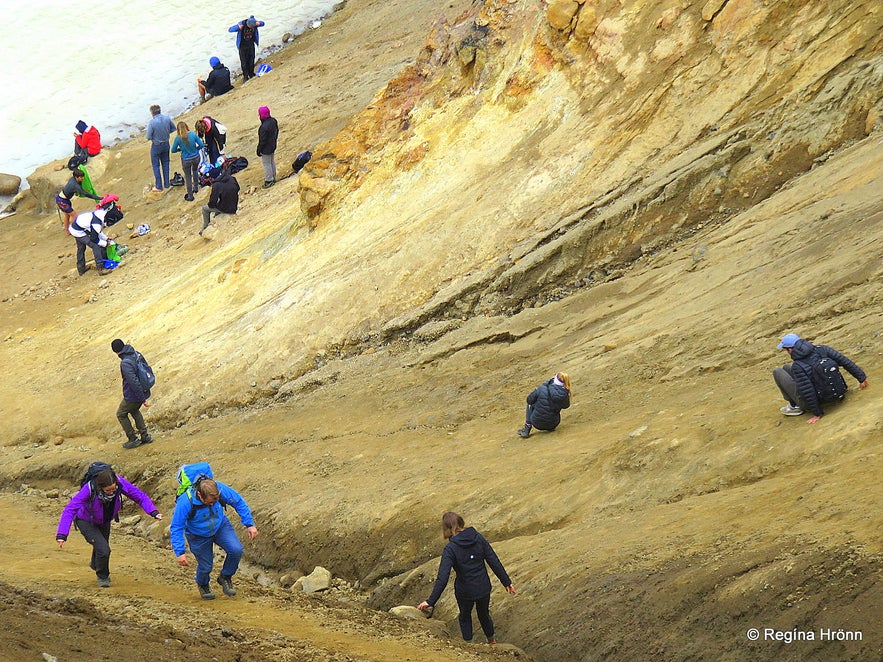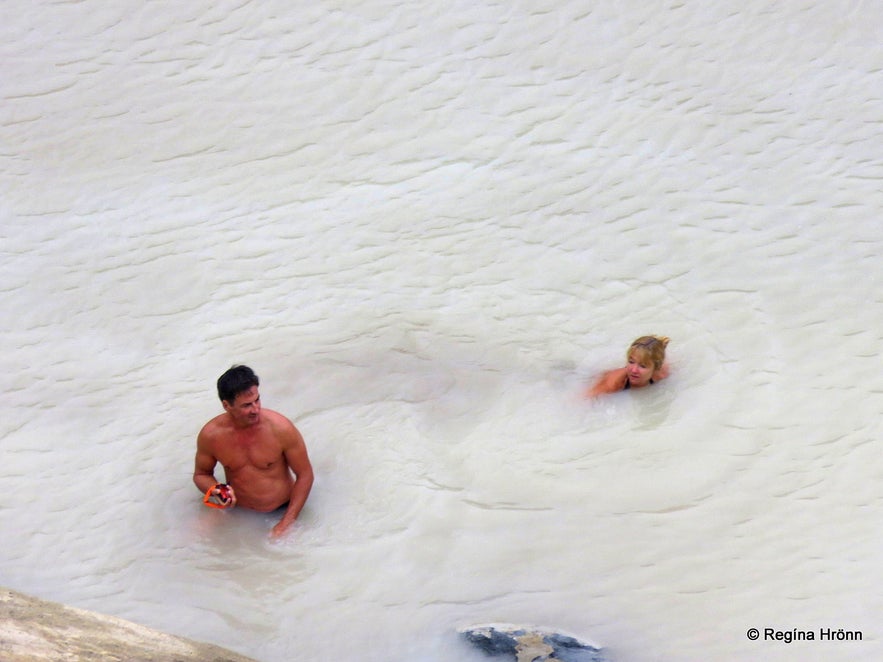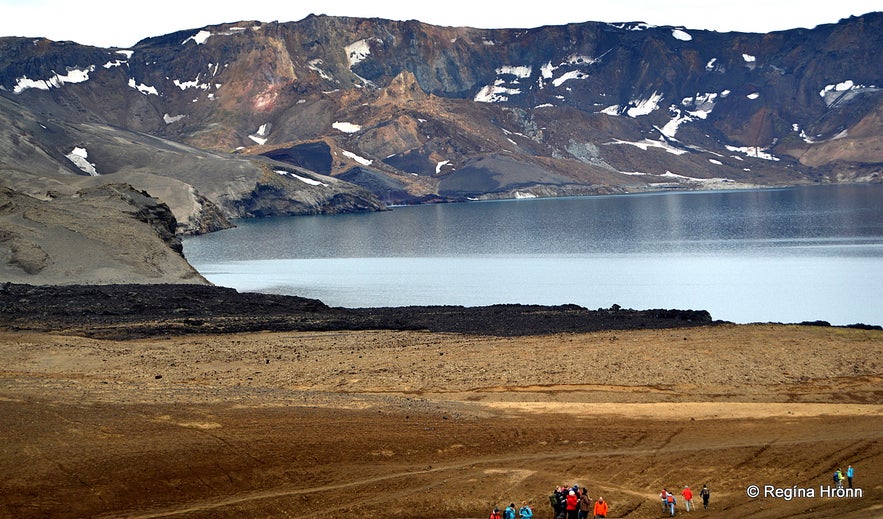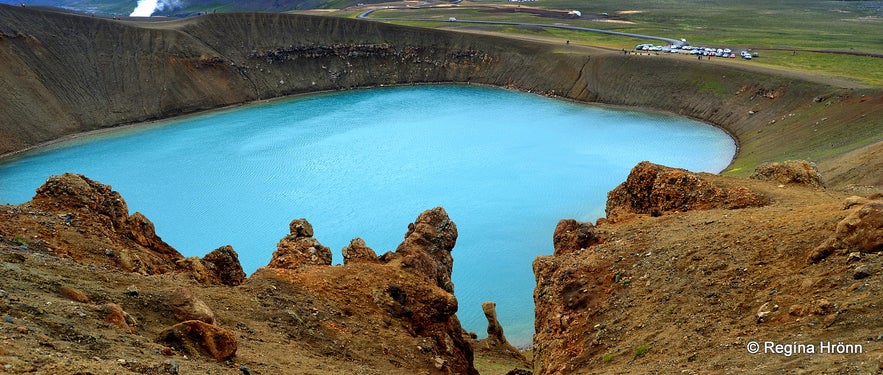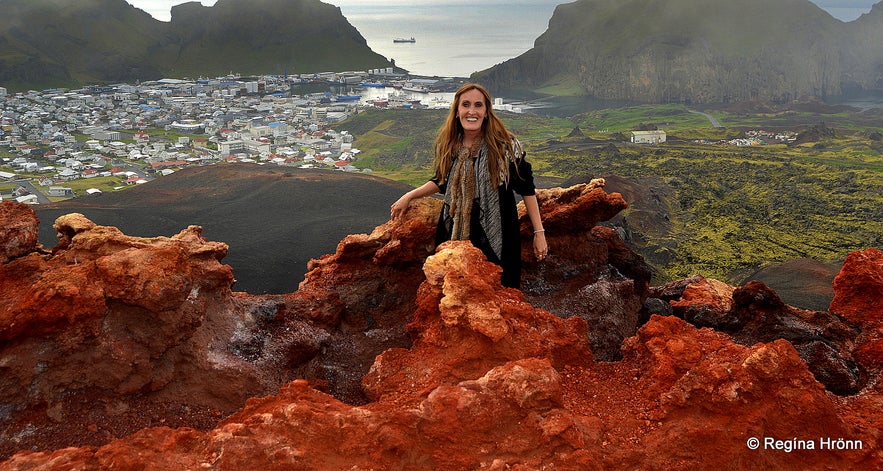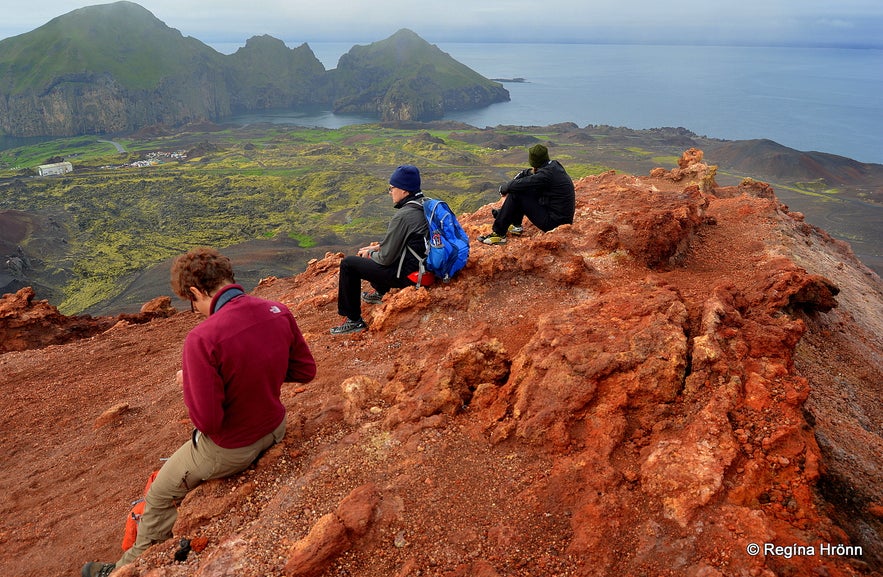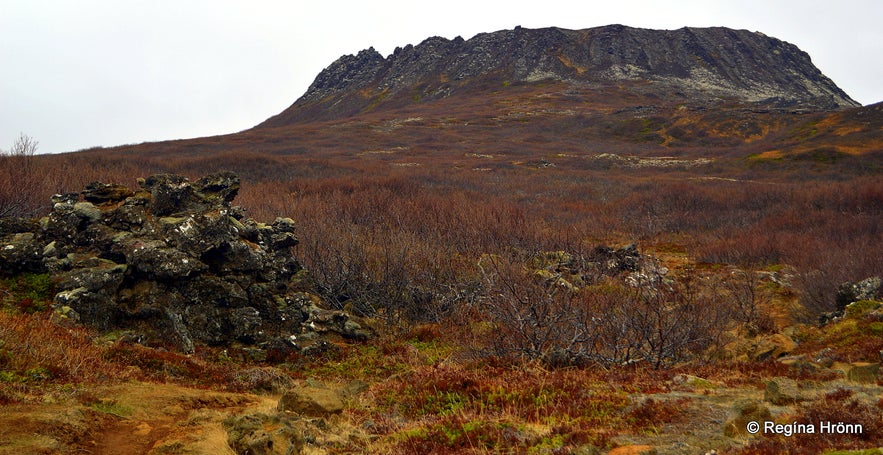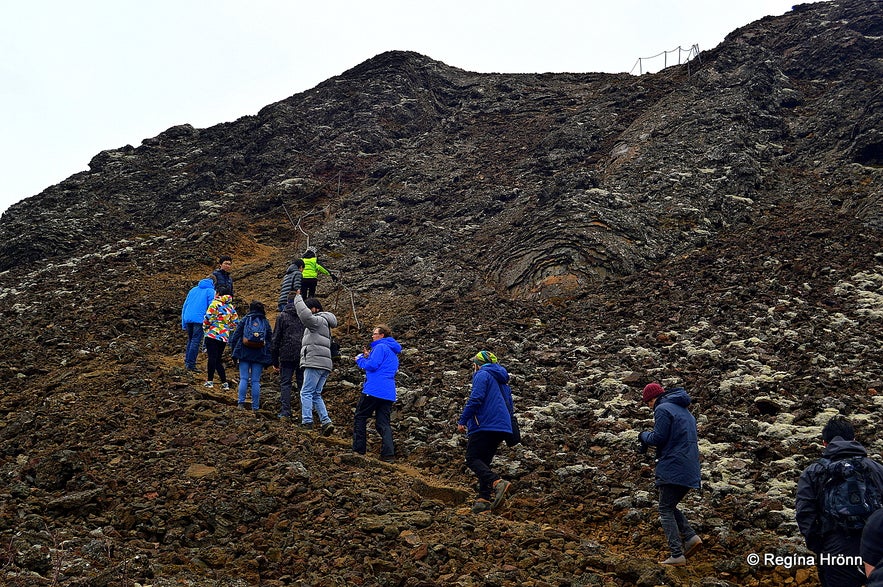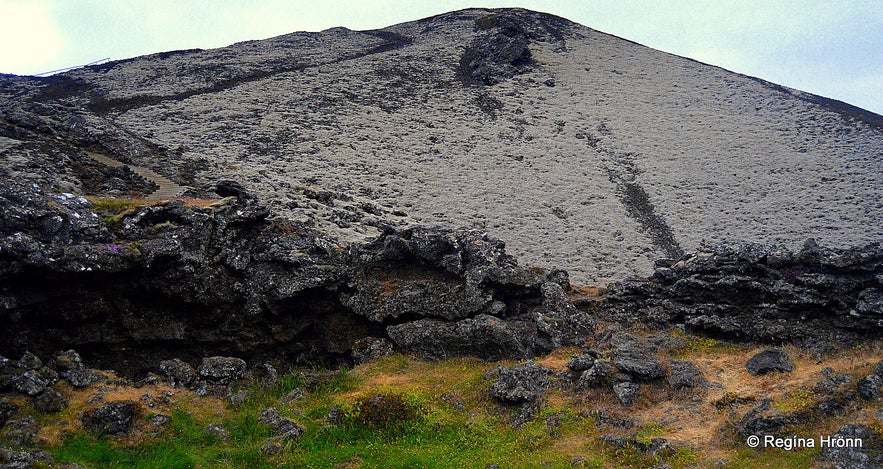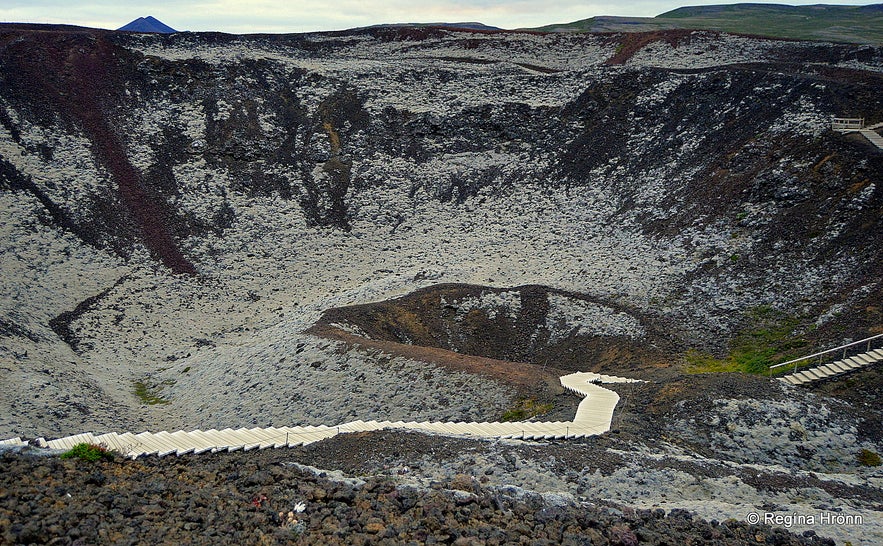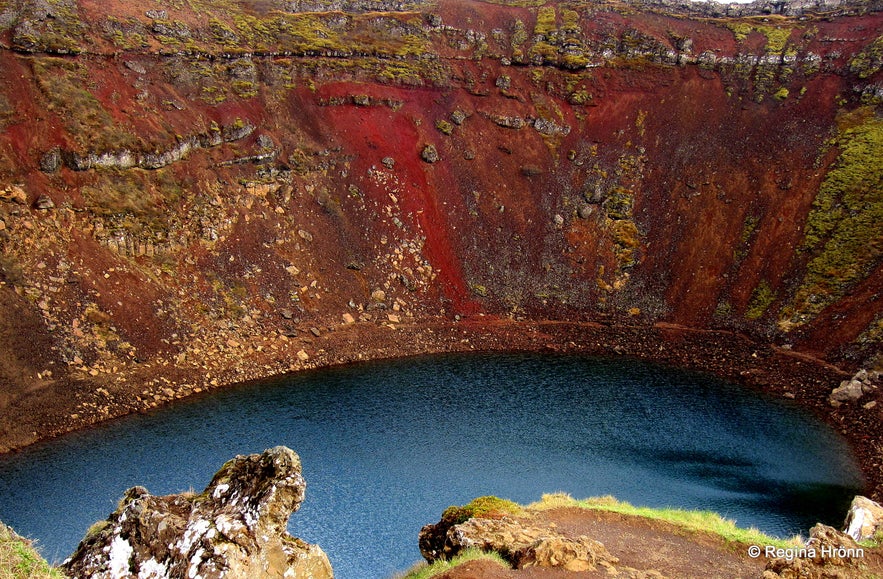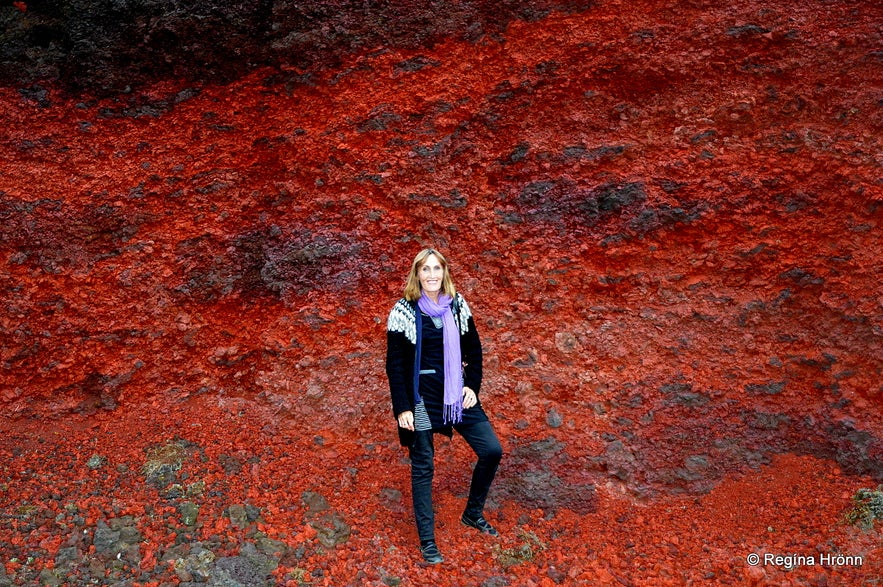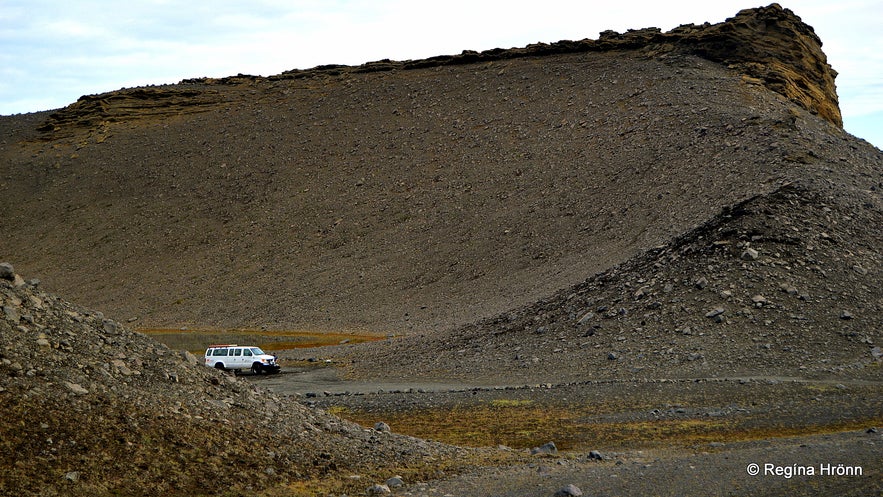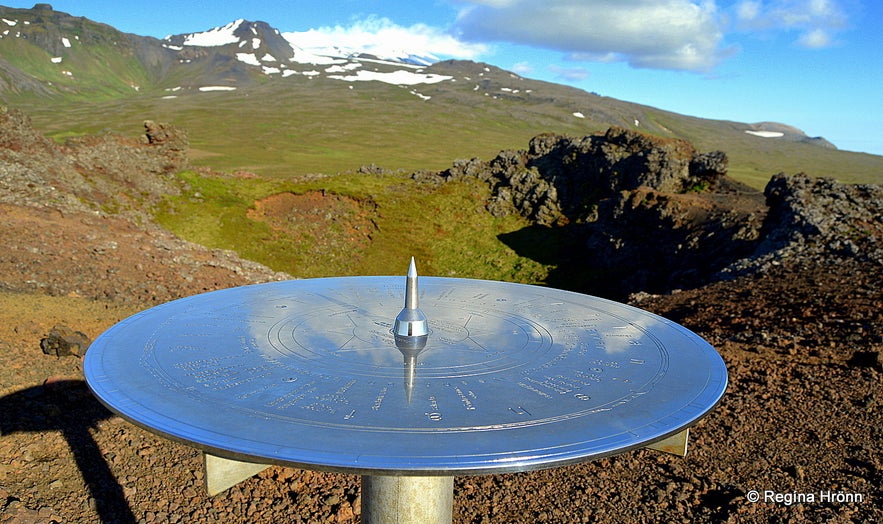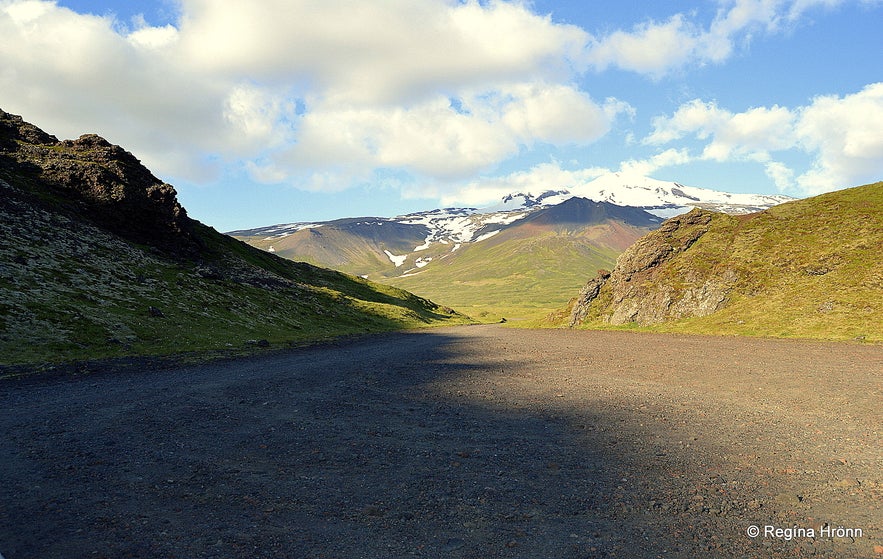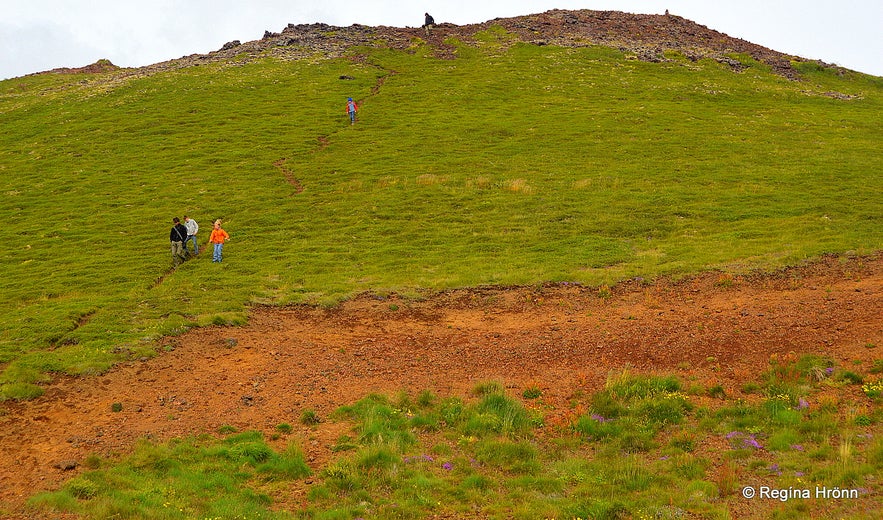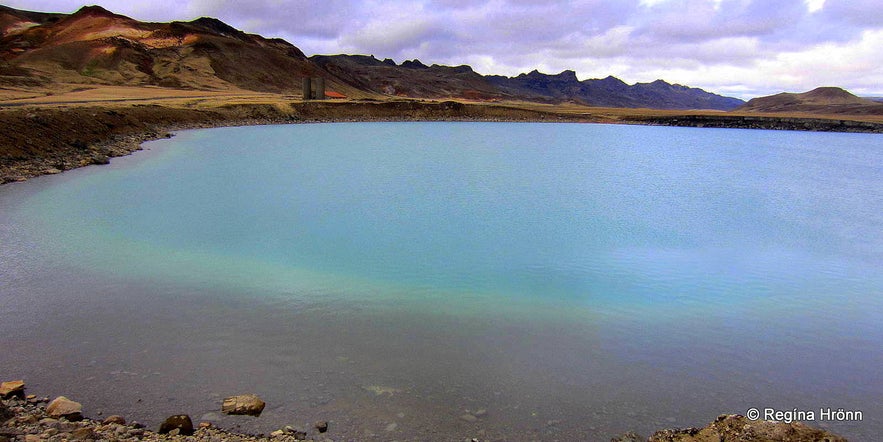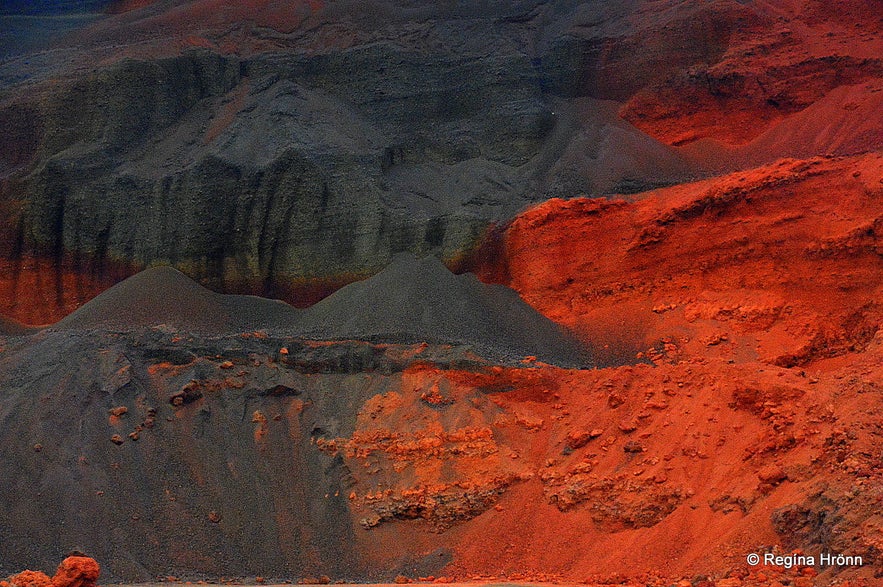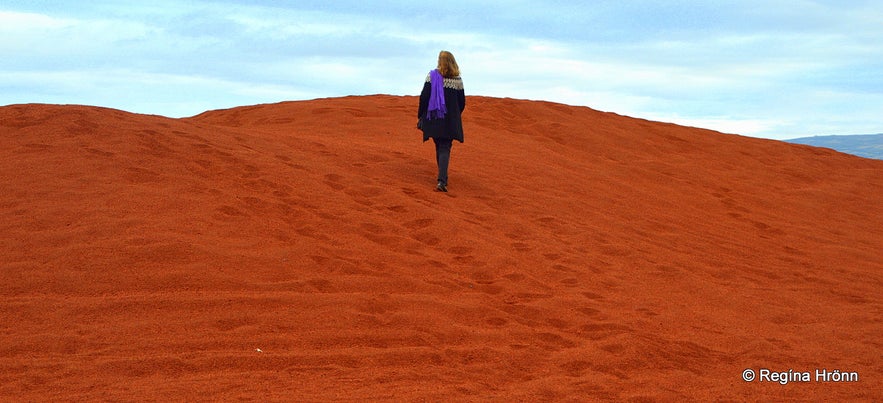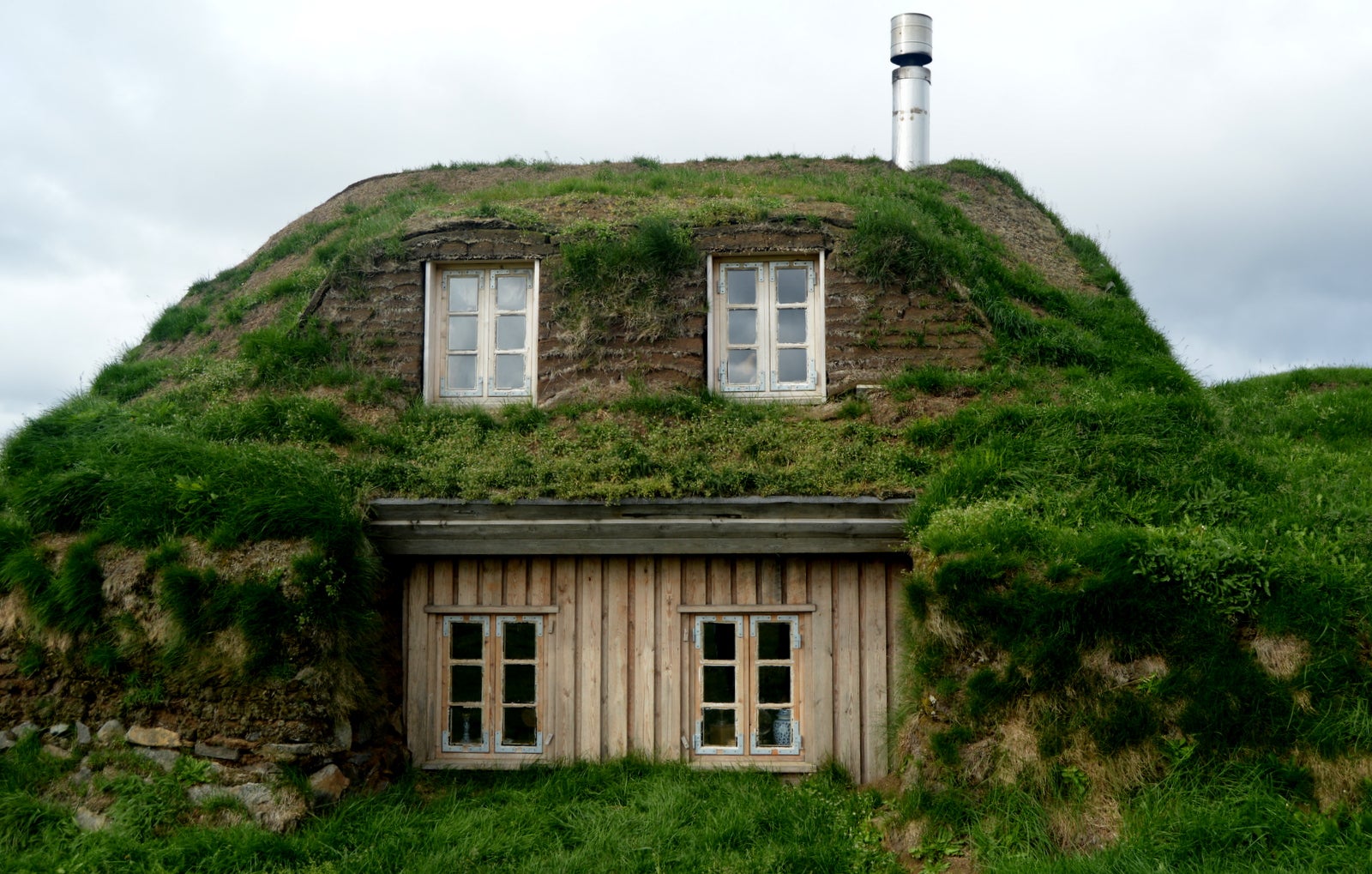Iceland is a volcanic island and around the country, you will
find some 130 volcanos. Most of them are inactive and you can visit the volcanic craters, some of which are lake-filled. One of them is even filled with warm whitish opaque geothermal water in which you can bathe, like Víti explosion crater in the Askja caldera in my photos above and below.
In this travel-blog, I am going to show you 9 of my most favourite craters, which I have visited on my travels in Iceland.
Top photo: Víti in Askja
No 1 - Geldingadalir craters
The volcanic eruption
On the 19th of March 2021, a volcanic eruption started in Geldingadalir on the Reykjanesskagi peninsula in SW-Iceland, after 3 weeks of constant earthquakes shaking the southwest corner of Iceland.
It is a small eruption of primitive lava coming straight from the earth's mantle, which makes it quite extraordinary. A volcanic eruption hasn't taken place in this particular location for 7,000 years and the last time a volcano erupted on the Reykjanesskagi peninsula was 800 years ago.
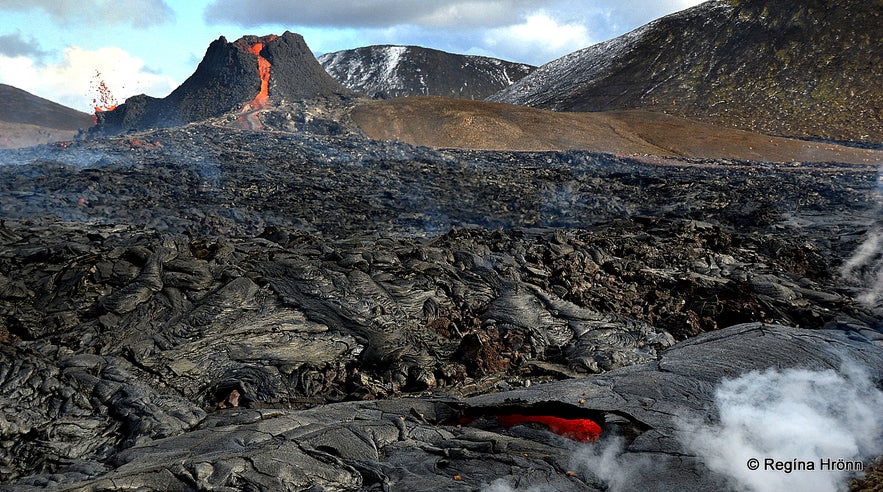
The volcanic eruption and the new lava field
Thousands of people started flocking to see the volcanic eruption, the whole nation was thirsty for something new after a year of COVID restrictions.
I have written a travel-blog about the eruption if you want to see more photos and a live camera from the volcanic eruption:
The Volcanic Eruption in Geldingadalir Valley on Reykjanesskagi in SW-Iceland
No 2 - Víti explosion crater in Askja
Víti explosion crater
I have visited Askja caldera twice on a guided tour. Öskjuvatn lake, which is the second deepest lake in Iceland, and Víti-Hell, the explosion crater next to it, got created back in 1875 in a volcanic eruption. Askja is located in the highland of Iceland so it takes some doing visiting it. That is why I join guided tours.
The hike from the parking lot to Öskjuvatn lake and Víti crater takes some 30-40 minutes, some of it through the snow. But the long drive and the hike are so worth it when you finally reach the very colourful explosion crater. It is 150 metres in diameter and half-filled with geothermal water, whitish opaque blue in colour.
You will for sure have a WOW moment when you see Hell, I know that I always do.
People sliding down to Víti crater
The sulphurous Hell is a popular bathing spot for the more daring of us. I have never bathed in the crater though, but I have worn my swimming suit on both occasions, just in case somebody else from the group wanted to dip in. No such luck yet...
It takes some doing getting down to the 22-26 degrees Celsius geothermal water of Hell as the walls of the crater are steep with loose gravel. I had fun photographing people trying to get into and out of the crater, knowing that I would probably slide all the way down to the geothermal water of Hell myself and not be able to get out of it again ;)
I zoomed in on people bathing in Askja
Hopefully one day I will be able to bathe in Víti, even though I am a bit scared of doing so, as on July 21st, 2014, two weeks before my first visit to Askja, we had some earthquakes and landslide up there, which caused a wave in Öskjuvatn lake, which is believed to have been some 50 metres high!
Water from the lake flowed into Hell and I can only imagine that the opaque water swung high as well! The water level rose some 2 metres in Öskjuvatn lake!
And a little later Holuhraun eruption started lasting for 6 months! You can see photos of Holuhraun in my second travel-blog about Askja.
Lake Öskjuvatn
In my photo above you see the crater of Askja and Öskjuvatn lake, which is right next to the explosion crater of Víti.
Read more in my travel-blogs: Askja volcano and the Highland of Iceland and an Amazing Tour to Askja and Holuhraun Lava Field in the Highland of Iceland
No 3 - Stóra-Víti in Krafla - Big Hell
Stóra-Víti
Up in North-Iceland, you will find the major volcano Mt. Krafla which contains another crater called Hell - this one is Stóra-Víti or Big Hell. This explosion crater, which is some 300 metres in diameter, was formed in 1724 at the beginning of the Mývatnseldar Fires (1724-1729). It is filled with the most beautiful azure blue lake.
The Krafla area is on the border of the Eurasian and North-American tectonic plates and is one of the many interesting sights in North-Iceland.
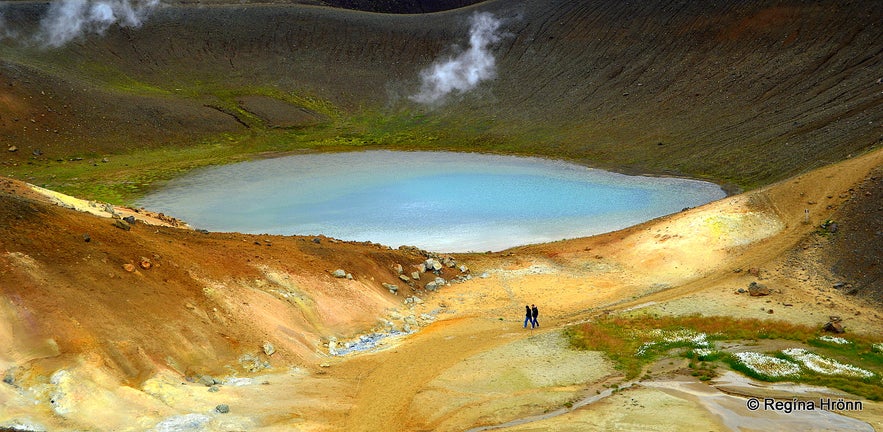
Krafla geothermal area
You can walk on the rim of Stóra-Víti and hike to the beautiful geothermal area behind the crater. This area is really colourful and worth a visit. It can get windy in Iceland so be careful while standing on the rim of the explosion crater. I have hiked up on the rim on a very windy day and almost flew off the rim and into the 30-metre deep Big-Hell!!
My photo below is of the geothermal area next to the explosion crater. It is strikingly colourful. Notice the two people to the left in my photo, who had wandered off from the trail to get closer to the colourful hot springs and mud pools. My heart sank when I saw them there.
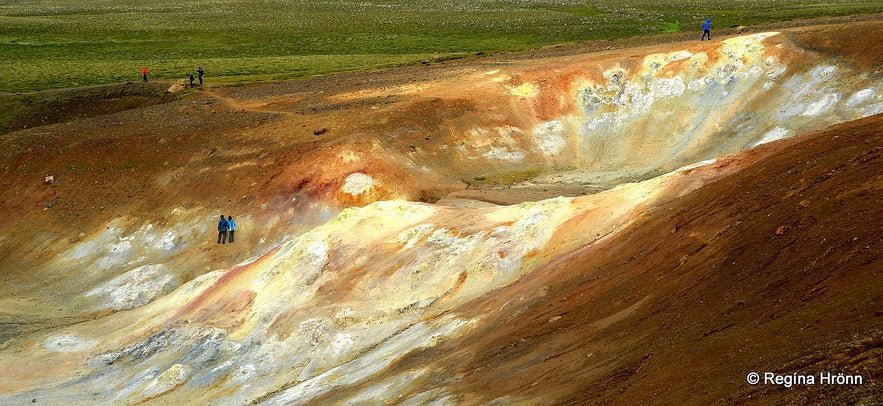
Krafla geothermal area
Mud pools and boiling hot springs lurk hidden away just beneath the surface and it is so easy to step through the crust and straight into the boiling water or mud! They probably didn't realize that they were in such danger.
They had a hard time returning to the trail, as you can see in my photo below. I zoomed in on them hoping they would be ok.
The trails are there for a reason, so stay on them so nobody gets hurt. The burn wounds from such accidents are dreadful, so I hope that my warning will not go unnoticed. We want our visitors to stay safe in Iceland.
Always stay on the trails in geothermal areas
After visiting this area, pay a visit to Leirhnjúkur, where you will also find extraordinary geothermal colours. Mt. Krafla caused quite a havoc in this area back in 1975-1984 with 9 eruptions and lava fountains up to 70 metres high, which lit up the sky! These eruptions are called the Kröflueldar Fires.
Read more in my travel-blog and see many photos of these beautiful geothermal areas: Mývatn in North-Iceland - Part IV - Mt. Námafjall, Krafla & Leirhnjúkur Geothermal Areas
No 4 - Eldfell crater in the Westman islands
On top of Eldfell crater in the Westman islands
A hike up to the maroon Eldfell volcano - the Fire Mountain, which got created in the volcanic eruption of 1973, in the Westman Islands, is a must when visiting these ever so popular islands.
When the volcanic eruption started on the 23rd of January 1973 all the inhabitants of the island had to flee to the mainland and some 400 houses were buried beneath the cinders or damaged by lava bombs. You can see one of the excavated houses at Eldheimar - the Pompei of the North Museum.
The more than 200 metres high Eldfell volcano got created in this volcanic eruption. A relatively easy, but somewhat steep hike takes you to the top where you have a fantastic view of the Westman Islands. The lava is bright red and yellow and is still warm in places.
On top of Eldfell crater in the Westman islands
The Westman Islands are located just off the south shore of Iceland and can be reached by ferry or by flight.
To visit the Westman Islands you can rent a car in Reykjavík and drive to Landeyjahöfn harbour and catch the ferry over to the islands.
Eldfell crater in the Westman islands
Read more in my travel-blog: Fancy hiking to the Top of Mt. Eldfell Volcano in the Westman Islands, which erupted back in 1973?
In this travel-blog, you will also find links to my 5 other travel-blogs of the Westman Islands, for ideas on what to see during your visit.
No 5 - Eldborg scoria crater
Eldborg scoria crater
Eldborg crater - the Fortress of Fire is a perfectly shaped, symmetric scoria crater on the boundaries of the popular Snæfellsnes Peninsula in West-Iceland. It was active some 5,000-8,000 years ago. Eldborg is around 250 metres long, 180 metres wide and 50 metres deep.
An easy 3 km hike, takes you to the roots of the crater. You can climb up to it and have a peek inside and a wonderful view of the other craters in this area, but Eldborg is a part of a ca 5-crater eruptive fissure.
Hiking up to Eldborg scoria crater
The crater is better looking though from below than from above, in my opinion.
The ascent up the volcano is 60 metres and rocky, but some chains have been fitted to make it easier to get to the top.
Read more in my travel-blog: A Hike to the perfectly shaped Eldborg Scoria Crater on Snæfellsnes in West-Iceland.
No 6 - Búrfellsgjá
This is the lava track
Búrfellsgjá gorge is a lava gorge where you walk in the track of a lava flow and up to a crater. It is located close to Reykjavík, so we take many of our visitors on a hike to this crater in Búrfell volcano. Búrfell, which rises 180 metres above sea level, erupted once some 8,000 years ago in an effusive eruption.
It is a really interesting hike, with small caves, fissures and lava formations along the way. You will even see a lava pen in one location.
This is the crater - the lava track is much more interesting in my opinion
The lava gorge is wide at the beginning of the track but narrows when you hike further up the gorge. The elevation is only 50 metres so it is not a strenuous hike.
You can walk around the crater and down to it, but I find the most interesting part of the hike to be the track of the lava flow and the view from it.
The crater er 140 metres in diameter and 58 metres where it is deepest.
Do also stop on the way to enjoy the lava colours and formations inside holes in the lava walls.
This lava flowed all the way to where you can now see Hafnarfjörður town - the Town in the Lava, which also goes by the name the Viking Town as there you can visit the Viking village and the Viking festival is held in Hafnarfjörður.
Búrfellsgjá
Here you can see the location of Búrfell on the map. To reach it you can rent a car and visit it by yourself.
No 7 - Grábrók crater
Grábrók crater
Grábrók - Grey pants, is the name of a small volcano in Borgarfjörður in West-Iceland. It is 170 metres high and created the lava-field Grábrókarhraun 3,200 years ago. Grábrók crater is a scoria crater. A popular easy hike straight from ring-road 1 takes you to the top of the volcano and paths and steps have been added to make the hike easier.
This area is preserved (since 1962) and the lava field is on the Natural Heritage Register. It is such a beautiful area where the landscape all of a sudden changes. No matter how many times I have driven through here I always marvel at its beauty.
Close to Grábrók volcano, you will find the waterfall Glanni and the serene Paradísarlaut pond. You can see what they look like in my travel-blog: The lovely Country Hotel Hraunsnef in West-Iceland and its beautiful Surroundings
Grábrók crater
In the summer of 2015, the moss in this beautiful lava field caught fire. A tourist on a bike did number 2 in the moss and lit the WC paper, which in turn set fire to the moss which spread over 200 sq.m., causing great damage to this area. Other tourists passing by thought that a volcanic eruption had started!
What we locals know and regard as common knowledge, is that you do not light a match in moss-covered areas. And now this visitor to our country found out the hard way :(
No 8 - Kerið crater
Kerið crater
Kerið is a beautiful lake-filled volcanic crater in South-Iceland. It is an oval scoria crater from a volcanic eruption some 6,500 years ago.
The colourful Kerið, with colours ranging from the most striking red to black to the most beautiful azure, is 270 m long, 170 m wide and 55 m deep. The depth of the lake has been measured ranging from 7-14 metres.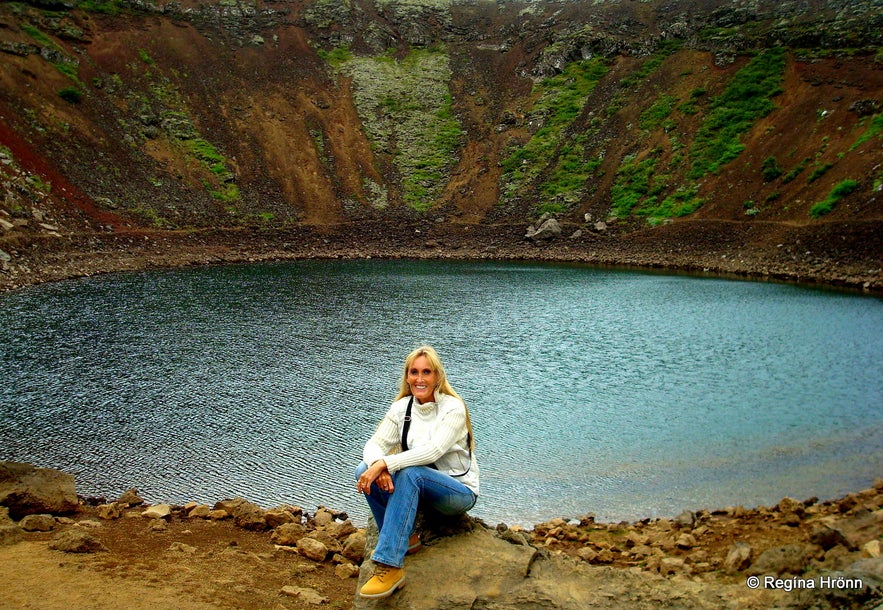
By the lake-filled Kerið crater
You can walk around the rim of the crater, which makes for a scenic walk. It is also possible to walk down to the lake itself. It used to be a popular picnic area amongst Icelanders, and concerts have been held by Kerið due to the good acoustics by the lake.
I have visited it so many times, as we used to have a summer cottage at Vaðnes, which is close by. You will notice many summer cottages in this area of Grímsnes.
Kerið belongs to a row of craters called Tjarnarhólar. There are other craters some of which are now used as a gravel quarry. I often stop by the other craters of Tjarnarhólar as the colours there are so diverse and very vivid.
Tjarnarhólar craters - it kind of looks like I have been photoshopped into this photo, doesn't it?
Other craters in this area are Seyðishólar (see the 2 last photos in this travel-blog) and Kerhóll.
Kerið is privately-owned and the land-owners are charging ISK 400 admittance fee. The admittance fee is used for the maintenance of this area.
Other interesting craters which I have visited on my travels
Hrossaborg crater
Hrossaborg crater in North Iceland is a 10,000-year-old scoria crater in the shape of an amphitheatre. The name Hrossaborg means Horse Castle or Horse City, and here horses were kept in earlier times as it kind of acts like a natural pen.
The highest crater rim of Hrossaborg is 441 meters above seal-level
Here you will find many sandstone images and it is the first stop on the tour to Askja before you enter the highland of Iceland. Here the drivers let out the air of the tires (33 psi to 15 psi) to give them a wider grip for the gravel roads in the highland.
Scenes from the film, Oblivion, starring Tom Cruise, were shot at Hrossaborg.
Saxhóll crater
The view-dial designed by my father-in-law on top of Saxhóll crater
My next 3 craters are located on the magical Snæfellsnes peninsula in West-Iceland and are all very accessible. The first one is the red 45 metres high Litli-Saxhóll crater. You ascend it via award-winning steps, which got awarded the Rosa Barba Landscape Prize in 2018.
This volcano erupted some 3-4,000 years ago and it takes some 5 minutes to reach the top. It is a bit taxing, but you can rest on a bench halfway up.
On top of the volcano, you will find one of the view-dials made by my father-in-law. Such view-dials show the names and height of the surrounding mountains. You will find them in many places in Iceland and I seek them out on my travels in my country.
Hólahólar craters
Hólahólar craters
Close to Saxhóll crater, you will find the Hólahólar craters - the Hills of Hills - which are a cluster of craters, but as with Hrossaborg crater, you can drive straight into one of the craters through an opening on the side of the crater.
Hólahólar looks like an amphitheatre and some people have even heard elves cheering and applauding from the hills of the crater. And one of our mediums saw many elves (hidden people of Iceland) in Hólahólar.
You can read more about these 2 craters, the elves and the beautiful Snæfellsnes peninsula in my 5 travel-blogs on Snæfellsnes, which are in chronological order.
The Purkhólar crater family
Purkhólar
Purkhólar crater is also on the Snæfellsnes peninsula. Purkhólar erupted some 8,000 years, creating several lava caves, amongst them the colourful Vatnshellir cave. You can join guided tours into this very interesting cave - Into the Underworld, where you will walk in the track of the lava flow.
A short hike up to the crater will reveal very colourful lava - red and pink and yellow. The crater itself is not very visible, but in one spot you will notice how the lava flowed. And you will have a lovely view; here you are by the roots of the magical Snæfellsjökull glacier.
Colourful lava at Purkhólar
Read more about Purkhólar in my travel-blog: the Colourful Vatnshellir Lava Cave on Snæfellsnes in West-Iceland & its Beautiful Lava Formations.
The explosion crater Grænavatn
The explosion crater Grænavatn
On the volcanic Reykjanes peninsula, you will see many craters, but one of the most accessible ones is the explosion crater Grænavatn - Green Lake, which got created in one explosion.
The crater is named after the lake in the crater, which is 46 metres deep and beautifully green in colour. Crystals and hot spring algae in the lake give the lake this distinctive green colour, which varies every time I visit this explosion crater.
The crater is located very close to the popular geothermal area of Seltún-Krýsuvíkurhverir, on which I have written another travel-blog.
Seyðishólar
Seyðishólar crater: a quarry, so they are not open to visitors, but they contain the most striking colours I have ever seen in a crater
Now, this is my take on the Icelandic craters, which I have visited on my travels in my country. There are so many craters in Iceland and I have only visited some of the more accessible ones.
But I think that the ones I have shown you are very interesting to visit, so I hope that you have enjoyed this travel-blog and have maybe got some ideas for your own Iceland visit.
The red sand of Seyðishólar
In another travel-blog, I show you the interesting phenomenon pseudocraters, which can be seen in very few places apart from Iceland and on the planet Mars.
Have a lovely time in Iceland :)



